How Long Does Spackle Take to Dry?
Author: Omar Alonso | Editor: Omar Alonso
Review & Research: Jen Worst & Chris Miller
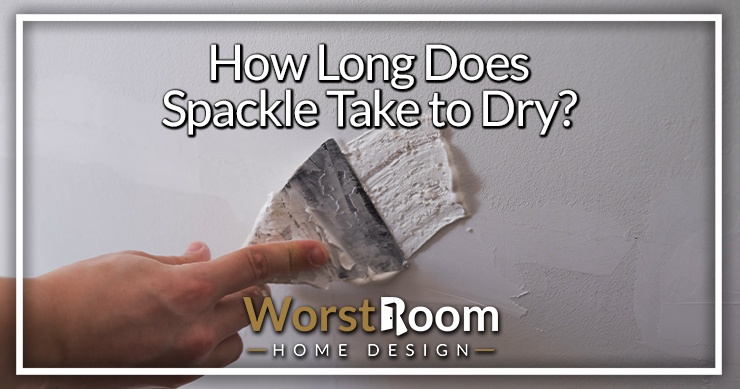
In this guide, we'll look into the various factors influencing drying time for spackle and provide tips on how to reduce it. We'll discuss the different types of spackle available and their specific uses for repairing your home. The question is how long does spackle take to dry.
In addition to answering how long does it take for spackle to dry, we'll delve into the factors affecting drying time and share some tips for speeding up the process. Furthermore, you'll learn how to properly prepare surfaces before applying spackle as well as techniques for applying and finishing with this versatile compound.
Lastly, we will address troubleshooting common problems with dried spackle so you can achieve a flawless finish every time. Stay tuned as we cover everything you need to know about working with spackle in your home repair projects.
Types of Spackle and Their Drying Times
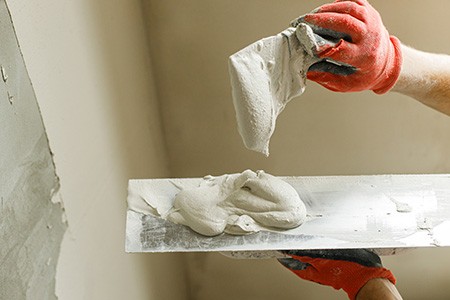
Different types of spackle have varying drying times, with fast-drying spackle taking just a few minutes to dry fully while traditional ones may require one to two hours.
Acrylic-based spackles are ideal for patching up deep gouges in materials like drywall, wood, and cement; these typically take between two to five hours to set completely. Lightweight gypsum-based solutions are suitable for repairing larger holes and cracks but might need more time than vinyl alternatives.
Fast-Drying Spackle
Fast-drying spackles are designed for quick repairs that don't require extensive drying periods. These products often contain additives that accelerate the drying process, allowing you to move on with your project faster. Fast-drying spackles can be a great option when you're in a hurry or tackling smaller tasks.
Traditional Spackles
In contrast, traditional spackles usually have longer drying due to their composition. They provide a strong bond and durable finish but may take one hour up to 24 hours before they're ready for sanding or painting. Nevertheless, traditional options work well when dealing with larger repair jobs requiring additional strength.
Acrylic-Based Spackles
Acrylic-based spackles, suitable for drywall, wood, and cement, are designed to offer superior adhesion and flexibility when filling deep gouges or cracks. They typically take two to five hours to set completely but offer excellent adhesion and flexibility. These products work well when repairing deep gouges or cracks in various materials.
Lightweight Gypsum-Based Solutions
Lightweight gypsum-based solutions are suitable for larger holes and cracks that require more substantial repairs. How long does spackle take to dry of the gypsum variety? While they may need longer spackling dry time than vinyl alternatives, their lightweight nature makes them easier to apply and sand once dry. This spackle can be a great option if you desire something that has both robustness and effortlessness of application.
Factors Affecting Spackle Drying Time
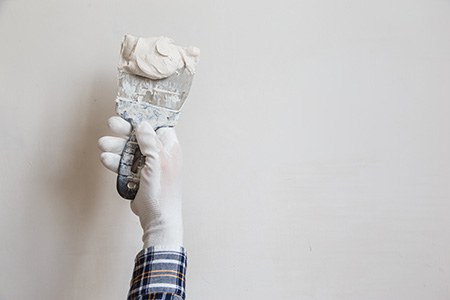
You can take this as how to make spackle dry faster. The drying process of the applied spackle can be influenced by environmental factors such as temperature and humidity. To achieve optimal results, it's essential to understand these factors and take necessary measures for controlling them.
Temperature Considerations
An ideal temperature range for the spackle drying process is 50-90 degrees Fahrenheit (10-32 degrees Celsius).
Consider using a space heater to maintain an appropriate temperature within your workspace when working in colder environments. Conversely, if you're working in hot conditions, ensure that there's proper air circulation with fans or air conditioners to help expedite the drying time.
Humidity Control Measures
In addition to temperature, high humidity levels can significantly slow down the spackle drying process. Utilizing dehumidifiers significantly reduces humidity levels, which contributes to accelerating the drying time. If you don't have access to a dehumidifier, opening windows and doors while running fans can also help reduce moisture content within your work area.
In conclusion, the drying time of spackle can vary depending on environmental factors. However, using fast-drying spackle or quick-drying spackle can help speed up the process.
Once the spackle is dry, lightly sand the surface and apply a coat of paint or primer. Vinyl spackling takes approximately 24 hours to dry, while lightweight spackle and spackling compounds can take up to 48 hours to dry completely.
Temperature and humidity determine how long the spackle will take to dry. To ensure the best results, it is important to properly prepare your workspace before applying spackle by gathering all necessary tools and materials, as well as taping off areas surrounding outlets.
Preparing Your Workspace Before Applying Spackle
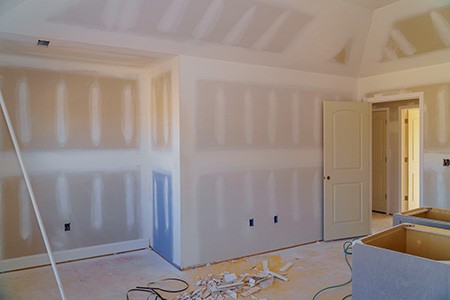
Before diving into your DIY wall repair project, preparing your workspace properly is essential. This ensures optimal results when applying any joint compound or filler material like spackle and helps prevent accidents and damage to surrounding areas.
Before you worry about how long does spackle take to dry, you need to get it applied first. Let's discuss some key steps in preparing your workspace:
Gathering Required Tools/Materials
To get going, collect the essential tools and components for the project. Some common items include:
- Spackling compound (either traditional or fast-drying spackle)
- A putty knife or a smaller blade specifically designed for these tasks
- Fine-grit sandpaper to lightly sand the repaired area once dry
- A drop cloth to protect floors and furniture from dust and debris
- Painter's tape for taping off edges around outlets and other fixtures
Taping Off Areas Surrounding Outlets
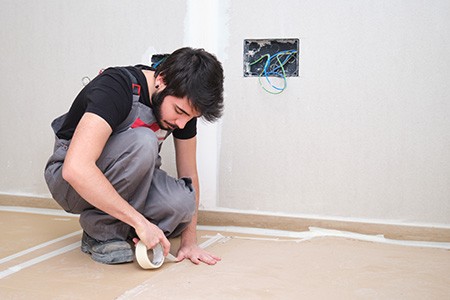
In order to protect electrical outlets, switches, baseboards, trim work, etc., use painter's tape (also known as blue tape) along their edges before starting with the spackling process. Additionally, remove outlet plates from surfaces being treated. This will help ensure that no accidental damage occurs while working on repairing walls or types of ceiling cracks.
Premixed compounds stored inside small tubs are convenient options since they're ready to use without needing additional mixing. However, if you're looking for a spackle that dries faster, consider using lightweight spackle or quick-drying spackle. These types of spackle dry faster than traditional vinyl spackling takes, which can speed up the spackle drying process.
Once you've applied the spackle, allow it to dry completely before sanding, unless you're repairing bubbled drywall tape, in which case you'll do some sanding before hand, too. Make sure you clean the surface from the dust completely, and allow it to dry if you use any moisture.
The drying time can vary depending on the type of spackling compound used and the thickness of the application. As a general rule of thumb, most spackle will dry within 24 hours. However, if you're using fast-drying spackle, it may dry in as little as 15 minutes.
After the spackle has dried, lightly sand the repaired area to create a smooth surface. Be sure to wipe away any dust or debris before painting or applying any other finishing touches.
By following these simple steps, you can ensure that your spackling project goes smoothly and that your walls look as good as new. Just be patient when it comes to the question of how long does spackle take to dry. Being patient is better than being hasty.
Tips For Speeding Up The Drying Process
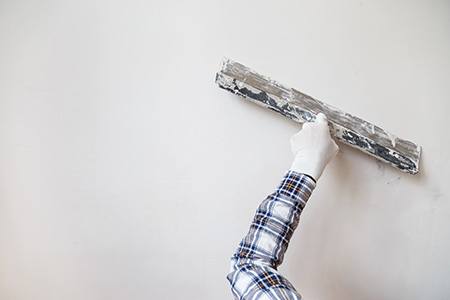
If you're looking for ways to speed up your project timeline without compromising quality results, consider investing in fast-drying formulas that claim eight times faster curing rates compared with other options available on the market today. Thinning out the surface during application and utilizing dehumidifiers/air conditioners can also help expedite drying times.
Using Quick-Drying Spackle
To ensure a quicker spackle drying process, opt for quick-drying spackle products designed specifically for the rapid completion of wall repair projects. These fast-drying solutions often contain added ingredients that accelerate the drying time significantly. Be sure to read product labels carefully and follow manufacturer instructions when using these specialized compounds.
Proper Application Techniques
Thin layers: Applying thinner layers of spackle will allow it to dry faster than thicker applications. This is because there's less material for moisture to evaporate from, resulting in a quicker overall drying process.
Air circulation: Ensure proper air circulation by using fans or air conditioners in the room where you're working on repairs. This helps promote evaporation and speeds up the spackle drying process.
Maintain optimal temperature: As mentioned earlier, an ideal temperature range is between 50-90 degrees Fahrenheit (10-32 degrees Celsius) for efficient spackling compound drying times. Make sure your workspace falls within this range while working on repairs.
Humidity control measures: Utilize dehumidifiers or air conditioning units to reduce humidity levels in the room, which can significantly speed up the drying process for spackle.
By following these tips and using fast-drying spackle products, you'll be able to complete your wall repair projects more efficiently without sacrificing quality results. Remember that proper preparation and application techniques are essential for achieving a smooth, professional finish on any home improvement project involving drywall repairs.
So How Long Does Spackle Take to Dry?
After studying the material, you now have a more comprehensive knowledge of spackle, how much time it requires to dry, and the procedures for prepping surfaces before application. If you're planning a home repair project involving spackle, remember that patience is key when waiting for it to dry.
So how long does spackle take to dry? It depends on the type and the conditions in the environment. Some will dry in 5 hours and in optimal conditions it’ll dry in as little as 15 minutes (enough to work with, but not cured), but go ahead and expect to wait a full 24 hours. It’s easier to plan this way, too, knowing that you won’t make a mistake in being too hasty.



